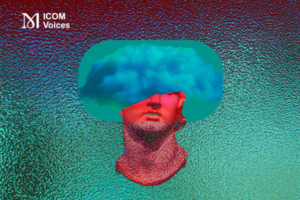In the last two decades, a growing body of evidence supporting the connection between museums and health has emerged, particularly demonstrating the role of art programmes in supporting mental health (Chatterjee and Camic, 2015). However, alongside the role of programs offered by museum institutions, it is interesting to explore how the museum environment, including its physical space, can impact the well-being of individuals. Which tangible and intangible spatial characteristics should museums consider to embrace a new idea of accessibility related to societal well-being? And ultimately which intersectoral strategies should they pursue to become key actors in social and health policies?
It is not coincidental that innovative experiences investigating the influence of cultural spaces on mental health emerged simultaneously with or following the pandemic. The Covid-19 pandemic had a profound impact redefining the relationship between museums and audiences, highlighting the vulnerability of this relationship.
In light of the international evidence presented in the 2019 WHO report titled ‘What is the evidence on the role of the arts in improving health and well-being?’ (Fancourt and Finn, 2019), in Italy, particularly in Piedmont, some pioneering projects have been initiated with the support of the Compagnia di San Paolo in Turin. These Italian projects aimed to evaluate not only the health benefits of artistic practices ― such as the DanzArte project, which translates emotional responses to art into physical movements through the use of multimodal and interactive technologies ― but also, more specifically, the connection between the quality of museum architectural spaces and the well-being experienced by visitors. In this article, I will present the Luoghi Comuni project, a multidisciplinary and participatory project developed by MinD Mad in Design, an association focused on improving young adults’ mental health through cultural activities.
LUOGHI COMUNI: MUSEUMS AS “EVERYDAY PLACES” FOR VULNERABLE COMMUNITIES
The Luoghi Comuni (Common Places) project was created in response to a call for ideas with the aim of investigating how the tangible and intangible aspects of cultural spaces positively impact mental well-being. The project originated from the need to promote the social inclusion of individuals with mental health fragilities by encouraging their participation in museums and cultural institutions. It also arose from the need to raise awareness among cultural institutions regarding certain vulnerable groups which often face societal stigma.
The project was implemented through a series of participatory initiatives involving cultural institutions in the city of Turin, with a strong emphasis on the active engagement of individuals who have experience with mental health challenges. It was structured around a series of guided cultural visits, offering individuals with experiences of mental fragility – along with their family members and healthcare professionals who are interested in developing new approaches of care – an opportunity to step away from the often uninviting and poorly maintained locations where mental health services are provided, that can often cause self-stigmatisation.
The project aims to encourage them to more frequently engage with cultural venues known for their attention to detail and aesthetically pleasing venues, characterized by care and beauty. The visits thus become an opportunity to convey to patients the value generated by the sense of care for places and the beauty of architecture. They also provided an occasion for patients, their families, and healthcare professionals to question whether and how these places would be capable of making individuals with mental fragility feel comfortable and regularly welcoming them as part of their audience, to finally consider museums as ‘common places’. For this project, the cultural centers and museums were carefully selected for their diverse environmental and spatial characteristics: from institutional museums situated in enclosed buildings (Fondazione Sandretto Re Rebaudengo, Camera Centro Italiano per la Fotografia) to urban green spaces (PAV Parco Arte Vivente) to new open centers for youth socio-cultural aggregation (Off Topic). This approach allowed for the evaluation, measurement, and reporting of the level of well-being generated by the cultural experiences, leveraging collectively established tools, guidelines, and criteria.
ASSESSING MUSEUMS’ INCLUSIVENESS THROUGH PARTICIPATORY ACTIVITIES
The project unfolded through a series of actions structured according to different levels of engagement aiming to foster social inclusion and cross-sectorial actions. An initial co-design workshop involved representatives from museums and cultural institutions, along with individuals experiencing mental health issues aiming to delve into the concept of a ‘gentle place’. This was achieved through the co-mapping of the city’s ‘feel-good’ cultural places, where a sense of well-being is experienced, and identification of their spatial characteristics. The evaluation encompassed elements such as hospitality, spatial arrangements, accessibility, engagement, communication, and internal organisation.
